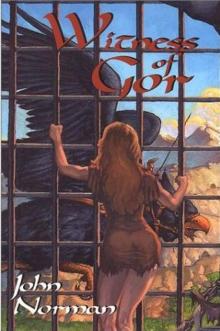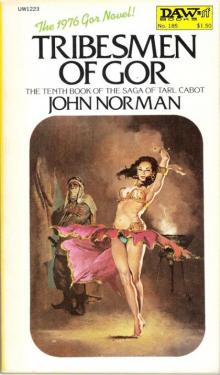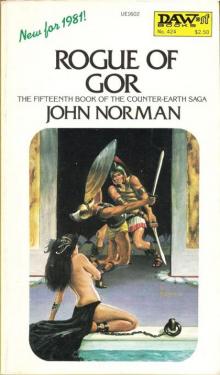- Home
- John Norman
Explorers of Gor coc-13 Page 13
Explorers of Gor coc-13 Read online
Page 13
“I am not a slave,” wept the girl. “I am not a slave.” Then she looked at me, suddenly, angrily. “You know that I am a slave, don’t you, you brute?” She asked, in English.
I said nothing to her.
“Is that why I hate you so much,” she wept, “because you know that I am a slave?”
I looked at her.
“Or do I hate you so much,” she asked, “because I want you as my master?”
Then she put down her head, again. “No, no,” she wept. “I am not a slave. I am not a slave!”
I then withdrew. I had no objection to the girl addressing herself to me in English, which she was confident I did not understand. I thought it healthy that she be given the opportunity to ventilate her feelings. Many Gorean masters permit a barbarian to prattle upon occasion in her native tongue. It is thought to be good for them.
A few minutes later I had joined Sasi on the blankets.
“Please touch me, Master,” she had begged.
“Very well,” I had said.
I glanced back once at the cage of the blond-haired barbarian. Shoka had covered it for the night.
I had seen her body and eyes proclaim her slavery, and I had heard her mouth both deny it, and affirm it, and then again deny it. The blond-haired girl was still fighting herself. She did not know yet who or what she was. Interestingly I had heard her ask herself if she hated me, because she wanted me as her master. I knew that a girl who wants a man for her master can perform wonders for him. And yet she was only an ignorant girl, a raw girl, new to the collar. What did she know of being the slave of a master? But then I recalled that she had again denied being a slave. I smiled to myself. What a little fool she was. She did not yet know. truly, that she was a slave.
“Oh, Master,” said Sasi.
Then I turned my attention away from the blond-haired girl, her intended role in my plans and what might lie ahead In Schendi. I then turned my full attention to the sweet, squirming, collared Sasi, the branded, curvacious little beast from the wharves of Port Kar. What a delight she was. She had none of the problems of the blond-haired girl. But, too, she was Gorean. Almost as soon as the collar had been locked on her she had begun, happily, to blossom in her bondage. Slavery is cultural for Goreans. They know it is something a woman can be.
“You give me great pleasure, Master,” she said.
“Be quiet,” I told her.
“Yes, Master,” she whispered.
A quarter of an Ahn later I held and kissed her, gently, letting her subside at her own rhythms. “What are you?” I asked her.
“A slave, Master,” she said.
“Whose slave?” I asked.
“Yours, Master,” she said.
“Are you happy?” I asked.
“Yes, Master,” she whispered. “Yes, Master.”
The Palms of Schendi had now begun to come about, about Point Schendi.
The yards swung on the masts, capitalizing on the wind. The oars dipped and lifted.
We were still some seven or eight pasangs from the buoy lines. I could see ships in the harbor.
We would come in with a buoy line on the port side. Ships, too, would leave the harbor with the line of their port side. This regulates traffic. In the open sea, similarly, ships keep one another, where possible, on their port sides, thus passing to starboard.
“What is the marking on the buoy line that will be used by Ulafi?” I asked Shoka, who stood near me, by the girls, at the bow.
“Yellow and white stripes,” he said. “That will lead to the general merchant wharves. The warehouse of Ulafi is near wharf eight.”
“Do you rent wharfage?” I asked.
“Yes, from the merchant council,” he said.
White and gold, incidentally, are the colors of the merchants. Usually their robes are white, trimmed with gold. That the buoy line was marked in yellow and white stripes was indicative of the wharves toward which it led. I have never seen, incidentally, gold paint on a buoy. It does not show up as well as enameled yellow in the light of ships’ lanterns.
I could see some forty or fifty sails in the harbor. There must then have been a great many more ships in the harbor, for most ships, naturally, take in their canvas when moored. The ships under sail must, most of them, have been entering or leaving the harbor. Most of the ships, of course, would be small ships, coasting vessels and light galleys. Also, of course, there were river ships in the harbor, used in the traffic on the Nyoka.
I had not realized the harbor at Schendi was so large. It must have been some eight pasangs wide and some two or three pasangs in depth. At its eastern end, of course, at one point, the Nyoka, channeled between stone embankments, about two hundred yards apart, flows into it. The Nyoka, because of the embankments, enters the harbor much more rapidly than it normally flows. It is generally, like the Kamba, a wide, leisurely river. Its width, however, about two pasangs above Schendi, is constricted by the embankments. This is to control the river and protect the port. A result, of course, of the narrowing, the amount of water involved being the same, is an increase in the velocity of the flow. In moving upstream from Schendi there is a bypass, rather like a lock system, which provides a calm road for shipping until the Nyoka can be joined. This is commonly used only in moving east or upstream from Schendi. The bypass, or “hook,” as it is called, enters the Nyoka with rather than against its current. One then brings one’s boat about and, by wind or oar, proceeds upstream.
The smell of spices, particularly cinnamon and cloves, was now quite strong. We had smelled these even at sea. One smell that I did not smell to a great degree was that of fish. Many fish in these tropical waters are poisonous to eat, a function of certain forms of seaweed on which they feed. The seaweed is harmless to the fish but it contains substances toxic to humans. The river fish on the other hand, as far as I know, are generally wholesome for humans to eat. Indeed, there are many villages along the Kamba and Nyoka, and along the shores of Lake Ushindi, in which fishing is the major source of livelihood. Not much of this fish, however, is exported from Schendi. I could smell, however, tanning fluids and dyes, from the shops and compounds of leather workers. Much kailiauk leather is processed in Schendi. brought to the port not only from inland but from north and south, from collection points, along the coast. I could also smell tars and resins, naval stores. Most perhaps, I could now smell the jungles behind Schendi. This smell, interestingly, does not carry as far out to sea as those of the more pungent spices. It was a smell of vast greeneries, steaming and damp, and of incredible flowers and immensities of rotting vegetation.
A dhow, with a red-and-white-striped sail, slipped past us on the port side.
The bow of the Palms of Schendi had now come about, and the peninsula of Point Schendi dropped behind us, to port. The impassive, painted eyes, white and black-pupiled, of the huge, brown kailiauk head at the prow now gazed upon the harbor of Schendi.
It lay dead ahead, some four pasangs.
The blond-haired barbarian looked across the deck to Sasi. “Mistress,” she whispered to Sasi, who stood to her as first girl.
“Yes, Slave,” said Sasi.
The blond lifted her bound wrists, the line running up to the golden ring in the left ear of the kailiauk head, through it, and back to the deck. “Why are we bound like this?” she asked.
“Do you not know, you little fool?” asked Sasi. I smiled, for Sasi was actually a bit shorter than the blond girl. I would have guessed they would have weighed about the same. Sasi may have weighed a little more. Neither was a large girl.
“No, Mistress,” said the blond girl. She was deferential to Sasi. If she had not been, she might have been whipped to within an inch of her life.
“Rejoice,” said Sasi. “You have been found beautiful enough to be put at the prow.”
“Oh,” said the blond girl, uncertainly. Then she knelt back, on her heels. She smiled. Then she looked up, uneasily, at the ring in the ear of the kailiauk head, that proud adornment surmount
ing the prow of the Palms of Schendi, through which her wrist rope was strung.
“On your bellies,” said Shoka to them, and the two girls lay on the deck.
He first crossed the blond’s ankles and tied them together, and then he did the same for Sasi. This is done to improve the line of a girl’s body, as she hangs at the ring.
“Up,” said Shoka to them, and they again knelt. Both were now ready to be put at the rings, the blond at the left, Sasi at the right.
We were now some three pasangs from Schendi.
A light galley, two-masted, with yellow sails, was leaving the harbor, far to port.
Coming about Point Schendi, behind us, some two pasangs astern, was a round ship. She flew the colors of Asperiche. Far to starboard we saw two other ships, a medium-class round ship and a heavy galley, the latter with red masts, both of Ianda.
“What will be done with us in Schendi?’ asked the blond-haired girl of Sasi.
“I do not know what will be done with me,” said Sasi, “but doubtless you will be marketed.”
“Sold?” asked the blond.
“Of course,” said Sasi.
Uneasily the blond girl squirmed a bit in her bonds, but they held her perfectly.
“Do not fear,” said Sasi. “You will learn to obey men with perfection. They will see to it.”
“Yes, Mistress,” said the blond. And then she glanced at me, and then, quickly, looked away. I continued to regard her. She knelt back as she could, her small ankles roped, a bit frightened, lifting her upper body. She displayed herself well. She trembled. She, an Earth girl, knew herself now subjected to the scrutiny of a Gorean male. She did not dare not to display herself well. She did not wish to be kicked or beaten.
Yet, as I regarded her, I saw more in her body and beauty than the mere intelligence of a collared slave.
I saw something, incipiently, of the joy and pride of the slave girl, the girl who knows that though her body is being placed in bondage her womanhood, paradoxically, is being freed.
I continued to regard her. Surely, at the beginning of the voyage, it never would have occurred to Ulafi to have put her at the prow. Better than that she would have been chained in the hold, to a ring, or caged on deck, the tarpaulin thrown over the cage, that she might not detract from the splendor of his entrance into his harbor. But Ulafi and Shoka had, in the voyage, accomplished much with her. She was now, incredibly enough, sufficiently beautiful to be found acceptable for the prow of the Palms of Schendi. What a subtle thing is a woman’s beauty. How little it has to do, actually, generally, with such matters as symmetry of form and regularity of features. It eludes scales and tapes; mathematics cannot, I think, penetrate its mysterious equations. I have never understood beauty; but I am grateful that it exists.
The girl looked up at me, and then, again, looked away. She put her head down, trembling.
I smiled, remembering her eyes. They had been those of a slave. How incredible that she did not yet know that she was a slave.
I pointed ahead, toward the harbor. It was now some two and a half pasangs away. “Schendi,” I said to her.
“Yes, Master,” she said.
“You will be sold there,” I told her.
“Yes, Master,” she said.
“Men will own you,” I said.
“Yes, Master,” she said.
“What do you want to do more than anything?” I asked.
“To please men,” she said, recalling well her training.
“Why do you wish to do that?” I asked.
She looked up at me. “Because I am a slave girl,” she whispered.
“Is it true that you are a slave girl?” I asked.
“Yes, Master,” she whispered. -
“Do you desire intensely to be a slave girl?” I asked.
“Am I in training?” she asked.
“Of course,” I said.
“Yes, Master,” she said, “I desire intensely to be a slave girl.”
“You are not now in training,” I said. “Do you desire intensely to be a slave girl?”
“No, no,” she wept. “No, Master. No, Master!”
“I see,” I said, and turned away from her. She knelt beside me, trembling, sobbing.
We were now some two pasangs out of Schendi. The traffic was heavier.
“Yes, Master,” she whispered.
I looked down at her. “What did you say?” I asked.
“Yes, Master,” she said.
“Yes, what?” I asked.
She looked up at me, tears in her eyes. “Yes, Master,” she said, “I do desire intensely to be a slave girl.”
“You are not now in training,” I told her.
“I know,” she whispered. “But I do desire, intensely, to be a slave girl.” She choked back a sob. Tears stained her cheeks. She bent her head to me and, delicately, softly, kissed me on the right thigh, below the tunic’s hem. Then she again, timidly, looked up at me. I did not cuff her.
“Have no fear,” I told her, “your wish is granted. You are completely and totally a slave girl.”
“Yes, Master,” she said. Then she put down her head. Her small fists clenched. “No,” she said, suddenly, “I am not a slave girl.”'’
“Fight the collar,” I told her. “In the long run it will do you no good.”
“Why?” she asked, looking up at me. “Why!”
“Because you are a slave,” I told her.
“No,” she said. “No!” But I saw in her eyes that she understood that I had seen the slave in her. She knew that I had recognized it. She had not been able to conceal her from me. It is very difficult for a woman when she meets a man who can see the slave in her. What then can she do? She can flee. or kneel before him.
“No,” she said, “I am not a slave!”
“Be silent, Slave,” I said.
“Yes, Master,” she said. She knelt back. I saw her body suffuse with a subtle pleasure, that she had been ordered to silence. Her protestations had not been accepted. Her immediate realities were simple. She was silent, ordered so, and kneeling. She had not wanted her protestations to be accepted, though it had been important for her to make them. Her resistance must be overcome. How else could it be clear to her that her will, truly, was subjected to that of another? Like all women, in her heart, she wished to be owned, and mastered.
She looked straight ahead, kneeling, her body held beautifully. She bit her lower lip. She tried to look angry.
I smiled to myself.
Already I could see many signs, some subtle and some quite obvious, that the secret slave, which lurks in every woman, had begun to sense, fearfully, excitedly, that she had been brought to a world on which she might perhaps be free at last to emerge; had the chains been removed; she lifted her wrists; had her small limbs now been unfettered; she looked up from the straw, up the long, narrow stairs toward the iron door; was it now ajar; since her birth a pathological culture had thrust her into the dungeon of suppression, confining her in the darkness; her very reality and existence had been ignored and hysterically denied; but at times, sometimes in dreams, or idle moments, her screams for mercy, unheeded, had been heard from the darkness below; or was it only the sound of the wind; I suspected that the blond-haired girl, uneasily, had many times heard the cries of the imprisoned slave; the slave now, her fetters struck away by Gorean men, crept toward the iron door; could it truly be ajar; had men opened it; outside the door the blond-haired girl, tremblingly, waited; the slave was going to emerge; but the slave feared to emerge; behind her the blond-haired girl heard strong men summon forth the slave; the slave would come forth; then the blond-haired girl would gasp, for she would see that it Was she herself who was the slave. Then she would feel a collar being locked on her throat, and she would kneel in the sunlight at the feet of a master.
“Put them at the prow!” called Ulafi.
Two seamen came to assist Shoka.
We were now some two pasangs out of Schendi. The traffic was heavier.
A heavy galley, out of Tyros, forty oars to a side, stroked past us, her yellow lateen sails loose on their yards. Crewmen paused in their labors to examine the beauty of the displayed slaves. Her captain, lowering his glass of the builders, lifted his hard high, fist clenched, to Ulafi, greeting him, and congratulating him on his ship and the girls which hung at its prow. Ulafi, graciously, lifting his hand, palm open, acknowledged the gesture.
We were then at the mouth of the harbor and, in a moment, had brought the line of yellow-and-white-striped buoys to port. There were already two ships behind us now, and another was ahead of us. As we moved toward the wharves three ships passed us, moving toward the open sea. There are more than forty merchant wharves at Schendi, each one of which, extending into the harbor, accommodates four ships to a side. The inmost wharves tend to have lower numbers, on the starboard side of the port, as one enters the harbor.

 Avengers of Gor
Avengers of Gor Kajira of Gor coc-19
Kajira of Gor coc-19 Mercenaries of Gor coc-21
Mercenaries of Gor coc-21 Witness of Gor coc-26
Witness of Gor coc-26 Witness of Gor
Witness of Gor Beasts of Gor coc-12
Beasts of Gor coc-12 Rebels of Gor
Rebels of Gor Mariners of Gor cog[oc-30
Mariners of Gor cog[oc-30 The King th-3
The King th-3 Captive of Gor coc-7
Captive of Gor coc-7 The Captain th-2
The Captain th-2 Vagabonds of Gor coc-24
Vagabonds of Gor coc-24 Explorers of Gor
Explorers of Gor Hunters of Gor
Hunters of Gor The Chieftan th-1
The Chieftan th-1 Outlaw of Gor
Outlaw of Gor Priest-Kings of Gor coc-3
Priest-Kings of Gor coc-3 Norman Invasions
Norman Invasions Marauders of Gor coc-9
Marauders of Gor coc-9 Kur of Gor coc-28
Kur of Gor coc-28 Time Slave
Time Slave The Chieftain
The Chieftain Kur of Gor
Kur of Gor Rogue of Gor
Rogue of Gor The Totems of Abydos
The Totems of Abydos Tribesmen of Gor coc-10
Tribesmen of Gor coc-10 Renegades of Gor coc-23
Renegades of Gor coc-23 The King
The King Tarnsman of Gor
Tarnsman of Gor The Usurper
The Usurper Captive of Gor
Captive of Gor Conspirators of Gor
Conspirators of Gor Smugglers of Gor
Smugglers of Gor Savages of Gor
Savages of Gor Savages of Gor coc-17
Savages of Gor coc-17 Fighting Slave of Gor
Fighting Slave of Gor Nomads of Gor coc-4
Nomads of Gor coc-4 Fighting Slave of Gor coc-14
Fighting Slave of Gor coc-14 Swordsmen of Gor cog[oc-29
Swordsmen of Gor cog[oc-29 Priest-Kings of Gor
Priest-Kings of Gor Guardsman of Gor coc-16
Guardsman of Gor coc-16 Hunters of Gor coc-8
Hunters of Gor coc-8 Dancer of Gor coc-22
Dancer of Gor coc-22 Prize of Gor coc-27
Prize of Gor coc-27 Conspirators of Gor cog[oc-31
Conspirators of Gor cog[oc-31 Slave Girl of Gor
Slave Girl of Gor Explorers of Gor coc-13
Explorers of Gor coc-13 Assassin of Gor coc-5
Assassin of Gor coc-5 Raiders of Gor coc-6
Raiders of Gor coc-6 Tarnsman of Gor coc-1
Tarnsman of Gor coc-1 Dancer of Gor
Dancer of Gor Outlaw of Gor coc-2
Outlaw of Gor coc-2 Guardsman of Gor
Guardsman of Gor Beasts of Gor
Beasts of Gor Ghost Dance
Ghost Dance Nomads of Gor
Nomads of Gor Prize of Gor
Prize of Gor Rogue of Gor coc-15
Rogue of Gor coc-15 Swordsmen of Gor
Swordsmen of Gor